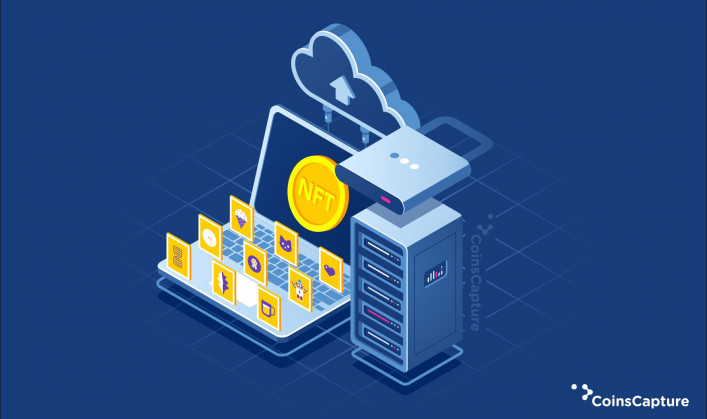7 November 2025
How To Store NFT Assets
Many Crypto enthusiasts' slogans over the years have been "Not your keys, not your Crypto" or "Not your keys, not your NFT". As we all know, NFTs have gotten a lot of attention and popularity in recent years, especially this year, with everything from licensed Marvel comic book covers to NBA players contributing their appeal and spending six figures on Bored Ape NFTs and everything in between; their popularity has grown and become the "talk" of the town.
Now, you probably might be wondering where and how the NFTs are stored, as well as how to keep them secure. The argument here is simple- when it comes to NFTs, they’re not only expensive but also have a lot of sentimental significance. As a result, you might want to consider keeping your non-fungible token somewhere safe. NFTs should be maintained in secure locations where your 12-word seed phrase, a password, or touch authentication can be used to protect the wallet. For optimal security, consider placing your NFTs in a cold storage hardware wallet. However, if you plan to keep your NFTs collectibles and investment, it's vital to keep them in a secure location/wallet.
Also read: Everything You Need To Know About NFT
What is the best method for storing NFT?
When it comes to collecting NFTs, deciding on the best manner to keep them is critical. Only one method of storing NFTs should be considered for safety and security reasons. Obtaining a cold storage hardware wallet and transferring your digital assets is the best approach to store your NFT, this protects your tokens from hackers and keyloggers by keeping them offline. For enhanced security, each hardware wallet comes with its own personal ID and password.
Even though NFTs are based on the Blockchain it does not imply that they are secure. If you don’t store your NFT properly then you risk losing its content and metadata. This can happen if the content of your token is saved on an HTTP URL and that link is changed in some way, your NFTs contract will remain on the Blockchain ledger but all of its content may be lost forever. Although losing your NFT is unusual, it is possible. Furthermore, if your NFT content is saved on a specific HTTP URL site and that site goes down you risk losing all of your Crypto-asset content as well.
Also read: A Comprehensive Guide To Create, Sell And Buy NFTs
Similarly, NFTs can be hacked too and they have been hacked a couple of times. According to a former CIA Professional Hacker, NFTs are just as vulnerable to hackers as emails and social media accounts. Users of the Nifty Gateway have already lost thousands of dollars due to art theft performed through hacking. Because a hack might happen at any time, it's preferable to be over-prepared. To avoid being hacked, you should keep your NFTs in a cold storage wallet.
Here’s a step-by-step guide to store your NFT assets:
- Lay It All Out:
One of the most appealing aspects of NFTs is that they are a well-established form of ownership based on Blockchains. However, what choices do consumers have, when it comes to transferring NFTs away from the marketplace where they were purchased? What are the many types of cold storage options? Why does any of this matter? In the mainstream Crypto discourse, these are some questions that are perhaps not questioned or debated nearly as frequently as they should be.
Hashes on IPFS- or the InterPlanetary File System gives NFT data its ubiquity (and thus, to a significant extent, it's worth). IPFS is a decentralized file system that allows users to access files from anywhere on the internet, regardless of whether or not they are stored centrally. Protocol Labs, the company that produced IPFS, is also the creator of Filecoin. In terms of storing and transporting verified data, the two protocols work in unison with Filecoin handling the storage element.
- More Data & Information, More Issues:
Since its debut, OpenSea, the world's largest NFT marketplace (and expanding) has enabled NFTs with decentralized information. It wasn’t until recently that the marketplace allowed creators to use IPFS and Filecoin when developing on the site. IPFS is safer because of its content identifiers (CIDs) which are hashes of data linked directly to the content of your NFT as opposed to an HTTP link, which may be updated and hacked. What is the significance of this? Smart contracts on Ethereum-based tokens, on the other hand, generate a function for locating metadata. Most significantly the value of the function is often stored on centralized servers (AWS, Google Cloud, etc). If the server goes down, your NFT may be difficult to locate. It's also worth mentioning that these smart contracts keep the possibility of developer modification open.
Also read: 15 Ways To Boost Engagement With NFTs
Naturally, each NFT project will be a little different. For example, CryptoPunks has a centralized mirror image with Larva Labs which allows Punks to be confirmed in the centralized server although image change is still technically possible. Because each NFT project has its own set of requirements your mileage may vary. NFTs marketplace platforms such as OpenSea, frequently offer “freezing” for NFTs. This enables users to freeze metadata, which is irreversible, and locks the metadata permanently; your NFT metadata will then be available for as long as Ethereum and Filecoin exist.
- Keep Things Simple:
When it comes to NFT storage there is no such thing as a one-size-fits-all solution. However, the safest and easiest solution is to keep your NFTs in a hardware wallet. Because all your data is stored fully offline and protected by a device password providing the maximum protection and making it nearly unhackable because it is so close to traditional and fungible Crypto cold storage. In most cases, these wallets can also restore device content if it is lost or stolen. When it’s connected to the internet these hot wallets remain secure allowing you to transact without risk of being hacked or contracting a virus.
Not long ago, Ledger published an internal document detailing how to connect MetaMask to a Ledger Nano and safeguard your NFTs. Therefore, Ledger is the most popular external wallet that can support NFTs and it will require an interface to display your NFT, such as MetaMask.
Also read: How Does NFT Games Work?
- Digital Solutions:
Your NFTs are stored off-chain with an IPFS like Pinata. Pinata is a cloud file storage and retrieval service designed specifically for NFTs which reduces the risk of being hacked. In addition, it also provides an IPFs API that enables data to be pinned to an IPFS node indicating its importance and allowing it to be easily accessible. This concludes that Pinata may “pin” your NFT data and make it easily, rapidly, and securely available. If a hacker node produces a CID hash, you will be alerted of the fraudulent data on your end. Consumers can even utilize numerous pinning services to boost data redundancy and confidence in data access.
Whereas, Arweave is a new unique initiative that intends to store documents, data, and applications permanently- the “permaweb” is also mentioned. Arweave is another popular consumer-facing decentralized digital solution that has built a “data Blockchain” called “Blockweave” which works similarly to a standard Blockchain. Miners relate to data that has been previously saved, similarly to how Blockchain would operate. Consider it as an online archive and hard drive maintained by the community. There’s NFT.Storage -NFTs on Filecoin and IPFS is supported by this new service which is currently in beta. NFT.Storage now supports three different types of NFT storage and has a 32GB file size limit.
Consumers should think about other new Blockchains that are changing to meet these needs in addition to these standard storage options. For instance, Enjin has created Beam- a Blockchain QR code solution for NFTs. Expect developing projects to play a larger role in future NFT projects as they mature.
As the market matures, we should expect to see additional software support tools develop.
Disclaimer: The author’s thoughts and comments are solely for educational reasons and informative purposes only. They do not represent financial, investment, or other advice.






